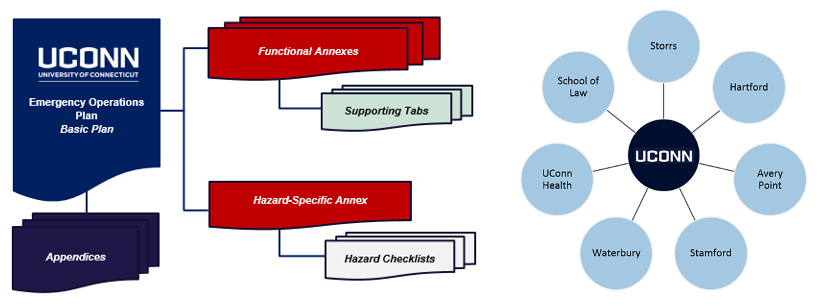The Basic Plan and Appendices are viewable by the public. To view the Functional and Hazard-Specific Annexes as well as UConn Health and John Dempsy Hospital Plans, you must Login using your NetID. The UConn Office of Emergency Management will grant access to these documents to authorized users.


Emergency Operations Plan Executive Summary
The Emergency Operations Plan meets current State of Connecticut and Federal statutory requirements. The Emergency Operations Plan contains:
- key concepts and activities of planning, response and recovery;
- a common concept of coordination, both internally and in partnership with external agencies;
- expectations and processes for gathering and sharing information, as well as decision-making;
- clear roles and responsibilities for key divisions, departments and offices; and
- provides resource management, finance and administrative guidelines for incident management.
The Emergency Operations Plan divides into three major parts:
- Basic Plan: Presents an enterprise framework for the emergency management program for UConn across all campuses (including UConn Health) and Education Abroad programs.
- Functional Annexes: Seven major annexes provide detailed considerations for emergency activities that are common across different types of incidents. These annexes contain an overview of UConn’s enterprise-level operations, concepts of operation for each campus and roles and responsibilities for each division, department or office that has an identified lead or supporting function. The Functional Annexes are:
- External Affairs and Public Information (public information, crisis communication, public education and outreach)
- Agricultural, Natural Resources and Animal Care (animal care, animal disease management, natural resource assessment and response, agriculture, water management, sustainability)
- Public Protection (public safety emergency communication, life safety programs, security programs, emergency response, protective actions)
- Infrastructure Systems (utility systems support, facilities management and assignment, roadway and access control, information technology systems)
- Human Services Support (sheltering and feeding, family reunification and assistance, donation and volunteer management, memorials/vigil planning, spiritual support services)
- Public Health and Medical (emergency medical services and mass casualty management, infectious disease response, fatality management, medical countermeasures, health care surge for the University community)
- Recovery and Mitigation (damage assessment, debris management, short and long term recovery planning, mitigation planning process)
- A Hazard Specific Annex: This Annex provides detailed considerations on how UConn will respond to a number of different specific hazards with a broad concept of operations containing actionable checklists. The Annex contains identified threats and hazards, including severe weather, active threat/violence/shooter, utility failure, mass casualty, mass fatality, pandemic influenza, significant events, explosion, bomb threat (including unattended package and suspicious package) and civil protest/unrest/demonstration, among others.
Confidentiality Notice
This site, and any contents or web pages attached, contains confidential and proprietary information that is intended for the exclusive use of University of Connecticut employees and authorized partners for the limited purpose of viewing material or submitting comments as part of the UConn Emergency Management Program. Only authorized University employees and partners are permitted to access this system and any unauthorized use of this system is unlawful. The information and material contained on this site is security sensitive information when labeled as such, and all authorized persons accessing the material have an obligation of confidentiality.